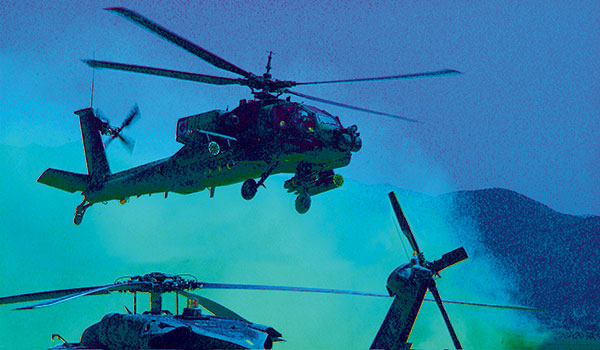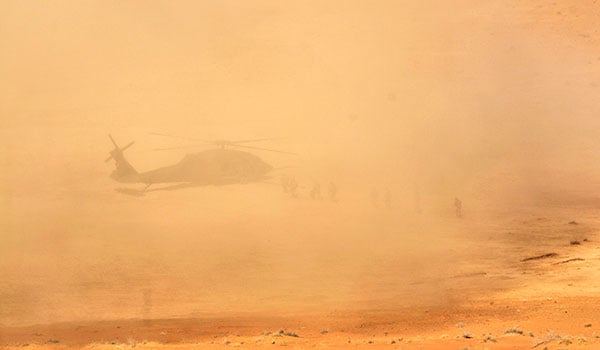
Combat Readiness Center Update / By BG Jeffrey A. Farnsworth and COL Michael D. Higgenbotham: The UH-60L Black Hawk aircrew has one minute and forty-seven seconds to live.
With the routine precision of countless iterations, the left and right crew chiefs clear the aircraft up and the pilot in command smoothly applies collective. The aircraft ascends into the dark night providing escort to the MEDEVAC aircraft en route to the assigned Category Alpha 9-line evacuation mission. Reported weather for the mission was skies clear, greater than 3 miles visibility, and zero illumination. The terrain surrounding the remote forward operating base was open and flat desert with a riverbed adjacent to the base, but no other good visual ground references or cultural lighting along the remaining route of flight. After completing the M240D weapons checks, a crew chief announces on the intercom system, “Oh my God, it is dark out here.” The pilot in command does not acknowledge this statement.

An Apache helicopter hovers while approaching a forward arming and refueling point in the Orgun province of Afghanistan.
A U.S. Army CH-47 Chinook helicopter causes a brownout as it arrives at a remote landing zone near Walan Rabat village in Shah Joy district, Afghanistan, March 22, 2012.
The aircrew has one minute and three seconds to live. The pilot on the controls banks the aircraft to the right, turning from a westerly departure off the pad to a heading of 030 while following the lead aircraft. CMOS has been armed, and the aircraft has now climbed to an above ground level altitude of approximately 800 feet. Both nonrated crewmembers state again on the ICS how dark it is and the fact they cannot see. The entire aircrew makes no additional preparations to operate in degraded visual environment (DVE).
The aircrew has twelve seconds to live. They lose visual reference with the ground. The combination of zero illumination and low contrast terrain, along with lack of a visible horizon due to dust in the air, essentially creates a zero-zero visual environment. The pilot on the controls does not acknowledge this condition and does not execute inadvertent IMC procedures.
The aircrew has four seconds to live. With the absence of outside visual reference and failure to immediately transition to instruments when IIMC, the pilot on the controls experiences type III incapacitating spatial disorientation (SD). Without the ability to understand the aircraft’s orientation, he pitches it 20 degrees nose low and rolls 135 degrees to the left. The aircraft departs controlled flight, impacting the terrain below and resulting in the deaths of all four crewmembers.
Greatest Contributing Factor
U.S. Army Combat Readiness Center (USACRC) mishap investigations continue to highlight that pilots losing situational awareness (SA) or becoming spatially disorientated within DVE continues to be Army Aviation’s greatest single contributing factor to Class A-B flight mishaps. Since the initiation of combat operations in 2002, this contributing factor has accounted for 24 percent of aircraft crashes and 44 percent of aviation fatalities. To highlight the urgency of this problem and bring senior leader attention to this mishap trend, the Army chief of staff issued his FY15 Army Safety and Occupational Health Objectives for aviation by setting the goal of reducing the loss of SA or SD mishaps in DVE by 50 percent. However, the trend to date shows we are moving in the wrong direction.

A U.S. Army CH-47 Chinook helicopter causes a brownout as it arrives at a remote landing zone near Walan Rabat village in Shah Joy district, Afghanistan, March 22, 2012.
FY15 is on track to be aviation’s fourth worst year for SD and loss of SA mishaps since 1990, with a loss rate of 0.75 for these factors – more than 2.5 times higher than the 10-year average of 0.30. This statistic equates in real terms to three aircraft lost and 11 fatalities this year. The rate of SD mishaps (per 100K flight hours) has varied during the past 25 years, with 1996 being our best year with zero SD mishaps. Our worst year of this time period, with a rate of 1.66, occurred in 2003 during the initiation of combat operations in the harsh desert terrain of Southwest Asia.
There is a fundamental difference between the FY03 mishaps and those that occurred this year. In 2003, almost every SD mishap (14 of 17) occurred during combat operations in unfamiliar terrain with enormous stress and pressure on the crews to accomplish their wartime mission. In stark contrast, all three loss of SA or SD mishaps this year occurred during training (two in CONUS and one in theater) where there was only perceived mission pressure and the easy ability to delay the mission until more suitable conditions were present.
The accident sequence described above clearly illustrates the problem aviators face while operating in DVE. In the past 25 years of USACRC mishap recommendations in cases involving loss of SA or SD within DVE, three clear trends emerge that are also present within this crash. The first is the need to improve aircrew understanding of the DVE environment; second is addressing systemic decision-making errors by aircrews; and lastly is implementing the enduring recommendation to improve basic skills necessary to control aircraft in reduced visibility and IMC.
Improving Understanding
To address the first trend of needing to improve aircrew understanding of DVE, the U.S. Army School of Aviation Medicine (USASAM) is performing the first comprehensive review and rewrite of basic doctrine of the physiological factors for loss of SA and SD. COL Mark McPherson, USASAM dean, said, “We will provide a simpler mental model to prevent spatial disorientation by providing pilots practical methods to recognize the conditions and countermeasures to respond to SD instead of rote memorization of illusions.” Revision of this portion of TC 3.04-93 aligns with the U.S. Army Aviation Center of Excellence (USAACE) commander’s efforts to “defrag the hard drive” by simplifying doctrine and providing a pilot what he or she needs to know.
The new doctrine will provide pilots reference material that is easily understandable, but more importantly, can be applied continuously within the aircraft as part of the aircrew coordination process with easy-to-apply indicators that conditions for SD are becoming prevalent. USASAM is working closely with the Directorate of Training and Doctrine as part of the ongoing Aircrew Coordination Training Working Group to nest new DVE indicators into revised training scenarios to give aircrews the tools to make timely decisions and effectively manage increased cockpit workload under these conditions.

The silhouette of a UH-60 Black Hawk helicopter is seen through a cloud of dust churned by its rotor blades as it picks up Soldiers from Alpha Company, 2nd Battalion, 25th Aviation Regiment, 25th Combat Aviation Brigade during air assault training in Kandahar province, Afghanistan, Feb. 29, 2012.
Crew Decision Making Errors
The second trend is systematic decision making errors by pilots in command while operating in DVE. In the scenario above, crewmembers commented on three occasions about the absence of illumination with no response from the pilot in command. More importantly, no aircrew coordination actions were directed by the pilot in command (PC) to determine performance degradation due to low illumination nor were any decisions made to select an alternate course of action. Another example is from the USACRC database’s first recorded incident of spatial disorientation occurring in 1972, which stated, “It was bad judgment on the aircraft commander’s part. After entering IMC, the aircraft commander elected to fly low level in the clouds to try and maintain visual contact with the treetops in mountainous terrain. The judgment and decision of the aircraft commander resulted in the aircraft crashing into the ridgeline.” In both cases, the PC’s decision to continue VMC flight in DVE conditions without visual reference to the ground led to the fatal crash of both aircraft. To assist commanders in training decision-making within DVE, the U.S. Army Aviation Research Laboratory (USAARL) is developing revised DVE training simulator scenarios that place aviators into DVE with a mission task to accomplish, based on actual mishaps provided by the USACRC. The scenarios are constructed to train the crew on both the physical task of flying in DVE and, more importantly, the decision-making necessary to avoid crashing the aircraft within the scenario. COL John Smyrski, USAARL commander, said that “by utilizing USAARL’s Black Hawk research simulator, our research team is developing realistic training scenarios for identifying and combatting spatial disorientation. The stop, start, and rewind benefits of this simulator-based training allows aviators to develop effective strategies to fly in any degraded visual environment while reducing the chances of an adverse outcome.”
IMC Flight Proficiency
The final, obvious trend is that aircrews should increase their instrument flight proficiency to be prepared to transition safely to IMC flight when operating in DVE. The repeated findings in SD and loss of SA mishaps in DVE include aircrew failure to properly transition to instrument flight during IIMC procedures or when executing a go-around during aborted dust landings. With an improper transition, the pilot is unable to execute the basic instrument skills taught in flight school of leveling aircraft attitude, turn only to avoid known obstacles, and initiate a climb. This task error invariably results in loss of aircraft control and impact with terrain or obstacles. Commanders already know the fix to this problem and can do so by assigning the appropriate number of task iterations on a pilot’s Commander’s Task List and prioritizing this training. There is also the additional responsibility of each pilot to take these opportunities and maximize every aircraft and simulator flight hour to maintain proficiency in their basic flight skills.
Training to operate effectively in DVE on our current generation aircraft is the bridging strategy that will get us to our future goal of “owning the environment.” Operating advanced aircraft systems in zero-zero weather conditions will place a significant burden on aircrews to understand their environment, make rapid and accurate decisions to accomplish their missions and keep their aircraft safe, and will challenge every aviator to properly execute basic flight tasks while in a task-saturated mission profile. We need to reverse the negative trends of 2015 and look to the future so every aviation unit is ready to cross the line of departure with the ground force, regardless of conditions.
BG Jeffrey A. Farnsworth is the Director of Army Safety and commanding general of the U.S. Army Combat Readiness Center; and COL Michael D. Higginbotham is the director of the USACRC Aviation Directorate, both located at Fort Rucker, AL.










